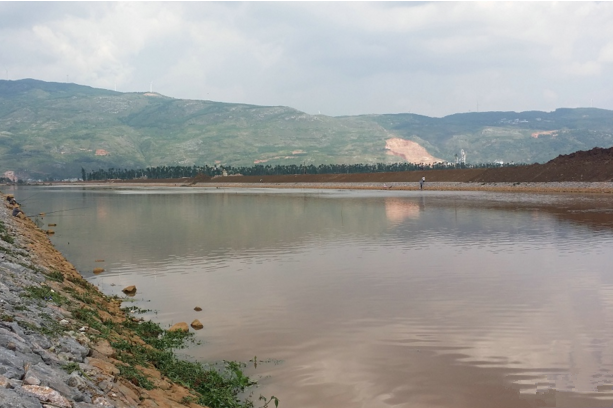
Dugong River in Luliang County, Qujing
Introduction
The Dugong River (杜公河) flows through the Sanchahe Town (三岔河镇) area, originating from the Guansheng Palace (关圣宫) in the Shagou Office (沙沟办事处). It draws water from the Laopan River (老盘江) and meanders through several locations, including Sanchahe, Qinghe (清河), Taijiatou (太家头), Wanning (万清), Zhaojiagou (赵家沟), Huangjiaxu (黄家圩), and Shuige (水阁) offices, ultimately discharging into the Central Plain (中原). The river serves multiple purposes such as flood diversion, drainage, and irrigation, with a total length of 18 kilometers. The riverbed is approximately 10 meters wide, with embankments that range from 3 to 5 meters wide and about 5 meters high.
Historical records indicate that in the 55th year of the Kangxi era during the Qing Dynasty (清康熙五十五年, 1716), the governor of Luliang (陆良), Du Zhen (杜珍), who was from Xinan, Henan Province (河南新安), visited the area due to flooding issues in the Dongxiang region (now Sanchahe Town). He oversaw the construction of embankments and the opening of the river, successfully alleviating the water disaster. To commemorate the achievements of Governor Du, the river was named Dugong River. This man-made river has a history of nearly 300 years and, despite renovations over the generations, its course has remained unchanged, still serving as a primary drainage and irrigation channel for the area. Villages along the river are closely connected, with farmhouses closely clustered together.
Sanchahe Town (三岔河镇)
Geographic Location
Sanchahe Town is located in the eastern part of Luliang County (陆良县), with its name derived from the convergence of three small rivers formed by the floodwaters of the Nanpan River (南盘江). The town government is situated 15 kilometers from the county seat. It borders Longhai Mountain (龙海山) to the east, adjacent to Wotao Village (核桃村) and Shuangqingkou Township (双箐口乡) to the north, Ma Street Town (马街镇) to the south, and Huaqiao Farm (华侨农场) and Zhongshu Town (中枢镇) to the west. The northern boundary connects with Banqiao Town (板桥镇).
Terrain and Elevation
The entire town is situated in a basin area, with Longhai Mountain rising in the east, reaching a maximum elevation of 2,686 meters. Residential areas and rice paddies are distributed within the basin, characterized by flat terrain and fertile land, with an average elevation of 1,830 meters.
Conclusion
Dugong River and Sanchahe Town are significant in both historical and geographical contexts, providing vital irrigation and drainage functions while serving as a cultural heritage site. The area showcases the harmonious relationship between human activity and the natural landscape.
How to Get There
To reach Dugong River and Sanchahe Town:
- By Car: From Qujing City (曲靖市), take the highway towards Luliang County. Sanchahe Town is approximately 40 kilometers from Qujing, which takes about one hour by car.
- By Public Transport: Buses run from Qujing City to Luliang County. Once in Luliang, local taxis or minibuses can be taken to reach Sanchahe Town, which is about 15 kilometers from the county center.
Travel Tips
- Best Time to Visit: The best seasons for visiting are spring (March to May) and autumn (September to November), when the weather is pleasant and the landscape is vibrant.
- Respect Local Customs: As this area is important to the local community, be respectful of local customs and practices when visiting.
- Bring Water and Snacks: Make sure to carry sufficient water and snacks, especially if you plan to explore the area.
- Photography: Capture the scenic beauty of the river and town, but be mindful of local restrictions on photography in certain areas.
- Plan for Weather: Check the weather forecast before your visit, as conditions can change quickly, especially in elevated areas. Bring appropriate clothing for varying temperatures.

Location:

 7 Days GolfingTour
7 Days GolfingTour
 8 Days Group Tour
8 Days Group Tour
 8 Days Yunnan Tour
8 Days Yunnan Tour
 7 Days Shangri La Hiking
7 Days Shangri La Hiking
 11 Days Yunnan Tour
11 Days Yunnan Tour
 6 Days Yuanyang Terraces
6 Days Yuanyang Terraces
 11 Days Yunnan Tour
11 Days Yunnan Tour
 8 Days South Yunnan
8 Days South Yunnan
 7 Days Tea Tour
7 Days Tea Tour
 8 Days Muslim Tour
8 Days Muslim Tour
 12 Days Self-Driving
12 Days Self-Driving
 4 Days Haba Climbing
4 Days Haba Climbing
 Tiger Leaping Gorge
Tiger Leaping Gorge
 Stone Forest
Stone Forest
 Yunnan-Tibet
Yunnan-Tibet
 Hani Rice Terraces
Hani Rice Terraces
 Kunming
Kunming
 Lijiang
Lijiang
 Shangri-la
Shangri-la
 Dali
Dali
 XishuangBanna
XishuangBanna
 Honghe
Honghe
 Kunming
Kunming
 Lijiang
Lijiang
 Shangri-la
Shangri-la
 Yuanyang Rice Terraces
Yuanyang Rice Terraces
 Nujiang
Nujiang
 XishuangBanna
XishuangBanna
 Spring City Golf
Spring City Golf
 Snow Mountain Golf
Snow Mountain Golf
 Stone Mountain Golf
Stone Mountain Golf



















